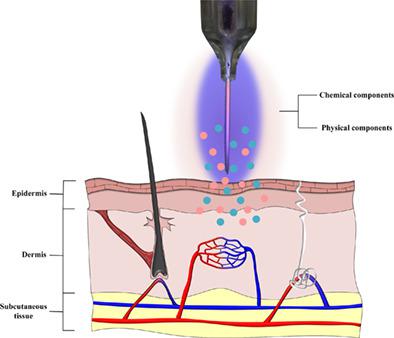当前位置:
X-MOL 学术
›
J. Biophotonics
›
论文详情
Our official English website, www.x-mol.net, welcomes your
feedback! (Note: you will need to create a separate account there.)
Cold atmospheric plasma applications in dermatology: A systematic review
Journal of Biophotonics ( IF 2.0 ) Pub Date : 2020-11-24 , DOI: 10.1002/jbio.202000415 Lu Gan 1 , Jian Jiang 2 , Jiang Wei Duan 3 , Xue Jing Zi Wu 1 , Song Zhang 2 , Xiao Ru Duan 2 , Ji Quan Song 1 , Hong Xiang Chen 2, 4
Journal of Biophotonics ( IF 2.0 ) Pub Date : 2020-11-24 , DOI: 10.1002/jbio.202000415 Lu Gan 1 , Jian Jiang 2 , Jiang Wei Duan 3 , Xue Jing Zi Wu 1 , Song Zhang 2 , Xiao Ru Duan 2 , Ji Quan Song 1 , Hong Xiang Chen 2, 4
Affiliation

|
Cold atmospheric plasma (CAP) applications can potentially lead to effective therapy for numerous skin diseases. Our aim is to systematically review the available data and map the use of CAP in dermatology. PubMed, Embase and Web of science were explored before 2020 for studies regarding the use of CAP in dermatology. A total of 166 studies were finally included. 74.1% of these studies used indirect CAP sources. Most studies used plasma jet (67.5%). Argon was the mostly used working gas (48.2%). Plasma application itself could be direct (89.2%) and indirect (16.3%). The proportion of studies with in vivo results remained 57.2%, of which most concerned direct plasma treatment (97.9%). Analyses performed indicate that CAP has been beneficial in many skin disorders. While, most CAP applications were focused on wound healing and melanoma treatment. This study provides a brief overview of CAP sources and relative medical applications in dermatology.
中文翻译:

低温大气等离子体在皮肤病学中的应用:系统综述
寒冷的大气等离子体(CAP)应用可能会导致许多皮肤疾病的有效治疗。我们的目标是系统地审查可用的数据并绘制CAP在皮肤病学中的用途。2020年之前,对PubMed,Embase和Web of Science进行了研究,以研究有关在皮肤病学中使用CAP的研究。最终共纳入166个研究。这些研究中有74.1%使用了间接CAP来源。大多数研究使用等离子流(67.5%)。氩气是最常用的工作气体(48.2%)。等离子应用本身可以是直接的(89.2%)和间接的(16.3%)。具有体内结果的研究比例仍为57.2%,其中大多数与直接血浆治疗有关(97.9%)。进行的分析表明,CAP在许多皮肤疾病中都是有益的。同时,大多数CAP应用程序都集中在伤口愈合和黑色素瘤治疗上。
更新日期:2020-11-24

中文翻译:

低温大气等离子体在皮肤病学中的应用:系统综述
寒冷的大气等离子体(CAP)应用可能会导致许多皮肤疾病的有效治疗。我们的目标是系统地审查可用的数据并绘制CAP在皮肤病学中的用途。2020年之前,对PubMed,Embase和Web of Science进行了研究,以研究有关在皮肤病学中使用CAP的研究。最终共纳入166个研究。这些研究中有74.1%使用了间接CAP来源。大多数研究使用等离子流(67.5%)。氩气是最常用的工作气体(48.2%)。等离子应用本身可以是直接的(89.2%)和间接的(16.3%)。具有体内结果的研究比例仍为57.2%,其中大多数与直接血浆治疗有关(97.9%)。进行的分析表明,CAP在许多皮肤疾病中都是有益的。同时,大多数CAP应用程序都集中在伤口愈合和黑色素瘤治疗上。












































 京公网安备 11010802027423号
京公网安备 11010802027423号